Magnetism and Matter-Revision Notes
CBSE Class 12 Physics
Revision Notes
Chapter-5
Magnetism and Matter
- Properties of magnets:-
(i) Attractive property
(ii) Directive property:- Magnetic materials tend to point in the north – south direction.
(iii) Like magnetic poles repel and unlike ones attract.
(iv) Magnetic poles cannot be isolated i.e. always exists in pairs. - Magnetic induction:- A magnet induces magnetism in a magnetic substance placed near it. This phenomenon is called magnetic induction.
- Magnetic field lines:- It is defined as the curve the tangent to which at any point gives the direction of the magnetic field at that point.
- Magnetic dipole:- An arrangement of two equal and opposite magnetic poles separated by a small distance is called a magnetic dipole.
- Magnetic dipole moment:- It is defined as the product of its pole strength and magnetic length.
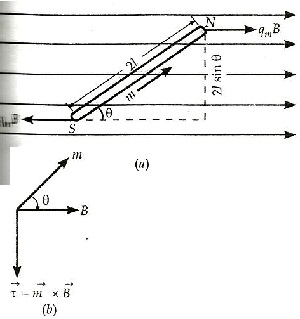
a) The force on it is zero.
b) The torque on it is
c) Torque on dipole will be minimum when = 0o
d) Torque on dipole will be maximum when = 90o.
e) When a bar magnet of dipole moment is placed in a uniform magnetic field , then its potential energy is where we choose the zero of energy at the orientation when is perpendicular to . - On the axial point of the dipole (end-on position):- Consider a bar magnet of size and magnetic moment m, at a distance r from its midpoint, the magnetic field at an axial point P is:

For r >> l,
On the equatorial point of the dipole (broadside-on position):- When a point P is situated on the equatorial line at a distance r from the centre of the magnet, then,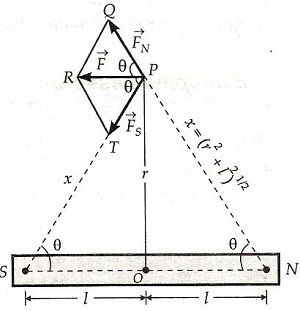
For a small magnet, r >> l, - Current loop as a magnetic dipole:- , where I = current flowing in the loop and A = area of the loop
- Gauss’s Law for Magnetism: It states that the net magnet flux through any closed surface is zero i.e.
- Analogy between electric and magnetic dipoles:-
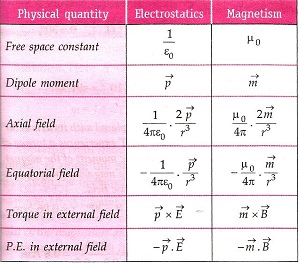
- Poles:
a) The pole near the geographic north pole of the earth is called the magnetic south pole.
b) The pole near the geographic south – pole is called the magnetic north pole.
c) The magnitude of the magnetic field on the earth’s surface = 4 x 10-5 T. - Elements of the Earth’s Magnetic Field: Three quantities are needed to specify the magnetic field of the earth on its surface:
a) The horizontal component of earth's magnetic field (BH)- It is the component of the earth's total magnetic field in the horizontal direction in the magnetic meridian.
b) The magnetic declination ()- The angle between the geographic meridian and the magnetic meridian at a place is called the magnetic declination at that place.
c) The angle of dip or magnetic inclination ()- The angle made by the earth's total magnetic field with the horizontal direction in the magnetic meridian is called angle of dip at any place.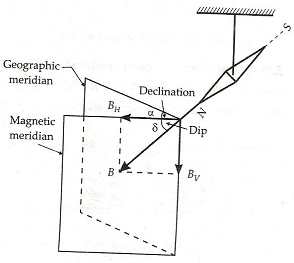
These are known as the elements of the earth’s magnetic field. Referring to the figure above:
BV = B sin - Neutral point:- It is the point where the magnetic field due to a magnet is equal and opposite to the horizontal component of earth's magnetic field. The resultant magnetic field at the neutral point is zero.
- Magnetic Intensity or Magnetising field intensity:- It is the ability of the magnetising field to magnetize a material medium. Let a material placed in an external magnetic field , then the magnetic intensity is,
- Magnetic induction:- It is defined as the total number of magnetic lines of force crossing per unit area normally through a material.
- Intensity of magnetization :- It is defined as the net dipole moment per unit volume and given by
Then the magnetic field in the material will be - Magnetic permeability () :- It is defined as the ratio of its magnetic induction B to the magnetic intensity H and is given by:
- Relative permeability () :- It is defined as the ratio of the permeability of the medium to the permeability of free space i.e.
- Magnetic susceptibility () :- It is defined as the ratio of the intensity of magnetization M to the magnetizing field intensity H i.e.
- Relationship between :- and
- Classification of Magnetic Materials: Magnetic materials are broadly classified as-
a) Diamagnetic- Those substances which develop feeble magnetization in the opposite direction of the magnetizing field. Examples- Bismuth, Copper, Lead, Zinc etc.
b) Paramagnetic- Those substances which develop feeble magnetisation in the direction of the magnetizing field. Examples- Aluminium, Chromium, Platinum etc.
c) Ferromagnetic- Those substances which develope strong magnetization in the direction of the magnetising field. Examples- Iron, Nickle, Cobalt etc. - Magnetic Susceptibility of the Material for Magnetic Materials:
a) For diamagnetic materials is negative and small.
b) For paramagnetic materials is positive and small.
c) For ferromagnetic materials lies between and
| Property | Diamagnet substances | Paramagnetic substances | Ferromagnetic substances | |
| 1. | Effect of magnets | They are feebly repelled by magnets. | They are feebly attracted by magnets. | They are feebly strongly by magnets. |
| 2. | In external magnetic field | Acquire feeble magnetisation in the opposite direction of the magnetising field. | Acquire feeble magnetisation in the direction of the magnetising field. | Acquire Strong magnetisation in the direction of the magnetising field. |
| 3. | In a non-uniform magnetic field | Tend to move slowly from stronger to weaker parts of the field. | Tend to move slowly from weaker to stronger parts of the field | Tend to move quickly from weaker to stronger parts of the field |
| 4. | In a uniform magnetic field | A freely suspended diamagnetic rod aligns itself perpendicular to the field. | A freely suspended paramagnetic rod aligns itself parallel to the field. | A freely suspended ferromagnetic rod aligns itself parallel to the field. |
| 5. | Susceptibility value | Susceptibility is small and negative. | Susceptibility is small and positive., where is a small number. | Susceptibility is very large and positive. |
| 6. | Relative permeability value () | Slightly less than 1 | Slightly greater than 1 | Of the order of thousands |
| 7. | Permeability value | |||
| 8. | Effect of temperature | Susceptibility is independent of temperature. | Susceptibility varies inversely as temperature: | Susceptibility decreases with temperature in a complex manner. |
| 9. | Removal of magnetizing field | Magnetisation lasts as long as the magnetizing field is applied. | As soon as the magnetizing field is removed magnetisation is lost. | Magnetisation is retained even after the magnetizing field removed. |
| 10. | Variation of M with H | M changes linearly with H. | M changes linearly with H and attains saturation at low temperature and in very strong fields. | M changes with H non-linearly and ultimately attains saturation. |
| 11. | Hysteresis effect | B-vector shows no hysteresis. | B-vector shows no hysteresis. | B-vector shows hysteresis. |
| 12. | Physical state of the material | Solid, liquid or gas. | Solid, liquid or gas. | Normally solids only. |
| 13. | Examples | Bi, Cu, Pb, Si, N2(at STP), H2O, NaCl | Al, Na, Ca, O2(at STP), CuCl2 | Fe, Ni, Co, Gd, Fe2O3, Alnico. |
- Hysteresis- The phenomenon of the lagging of magnetic induction behiind the magnetising field is called hysteresis.
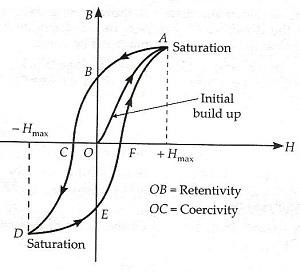
The magnetic induction left behind in the sample after the magnetising field has been removed is called residual magnetism or retentivity or remanence.
The value of reverse magnetising field intensity H required for the residual magnetism of a sample to become zero is called coercivity of the sample. - Permanent Magnets: Substances which retain their ferromagnetic property for a long period of time at room temperature are called permanent magnets. These magnets have High retentivity, High coercivity, High permeability.
- Electromagnets: High permeability, Low retentivity.